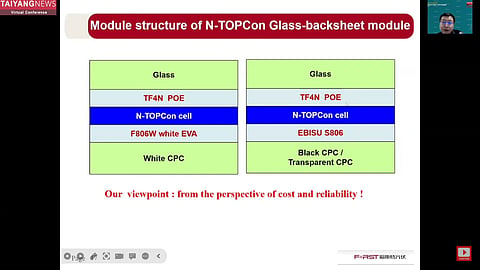

Reliability stands shoulder to shoulder with power as a crucial attribute of a solar module. While various factors influence a module's longevity, polymer wraps, which encompass both encapsulation materials and backsheets, play a key role. This importance intensifies with TOPCon. Addressing this critical topic was the focus of Hou Hongbing's presentation on the 1st day of TaiyangNews' annual flagship event High Efficiency Solar Technologies 2023 – Today, Tomorrow And Beyond. Hongbing, technical director at Hangzhou First, the world's leading encapsulation material supplier and a prominent backsheet vendor, presented the company's latest encapsulation solutions specifically designed for TOPCon modules. His presentation centered on tackling 2 degradation mechanisms – moisture-induced degradation (MID) in glass-backsheet modules and potential-induced degradation (PID) in glass-glass configurations.
Solutions for glass-glass
It is well known that glass-glass is now the primary choice for module configuration, especially with TOPCon. The option for encapsulation here is either using EPE – a coextruded film consisting of a thin film of POE sandwiched between 2 layers of EVA – on both sides, or EPE on the front and EVA on the rear side. Hongbing emphasized that both configurations qualify in reliability tests. For example, the modules using EP304 series EPE and F406PS series EVA passed the reliability tests with less than 5% power degradation. The reliability tests consisted of a PID test for 480 hours and a damp heat test for 3,000 hours (DH3000). The key to the anti-PID performance of an EPE film is the thinness uniformity of the POE center film, according to Hongbing. He showed that the ultra-thin layers of POE with varying densities from 90 to 150 gm/m2 have resulted in a power loss of less than 1.5% after 96 hours of PID test; and when the test duration tripled to 288 hours, the power loss still remained at less than 2.5%, showing good PID resistance.
Hangzhou First's Encapsulant for Glass-Backsheet Module using n-TOPCon cell
Unlike glass-glass, the glass-backsheet configuration faces many challenges. Hongbing presented the results of a pressure cooker test (PCT) on glass-backsheet module based on different standard encapsulation materials – EVA, EPE, and POE. The outcome: while POE withstood the test conditions the most, it still poses the risk of corrosion. Hongbing mainly attributes the degradation to moisture ingression through the backsheet and also from the edges. This, when combined with sodium and calcium ions from the glass, additives from the encapsulation and acetic acid with the use of EVA, forms a complex electrolyte environment called a salt bridge that leads to the corrosion of all metallic constituents of the modules such as contacts on cells and ribbons.
To overcome these limitations, Hangzhou First developed a new POE-based encapsulant series, called TF4N, with a blocking ion mobility feature. Hongbing showed that the film, when used on the front side, endured the 192–hour pressure cooker test conditions, surpassing the level of other encapsulants. He further showed that when the TF4N encapsulant is used on the front side, the choice of rear encapsulation material becomes less critical, meaning even EVA can be used on the rear side. However, better results are attained with a new class of acid-resistant EVA called EBISU. Developed by Japan's Kyocera, EBISU reduces the release of acetic acid from EVA. Hangzhou First has licensed the technology with exclusivity. The TF4N POE on the front even lifts the requirement for low WVTR backsheets. This means that backsheets with aluminum film or high barrier materials to keep the moisture ingression at very low levels are no longer required, facilitating the use of standard CPC backsheets, which are mainstream these days.
Reflective black-backsheet
In addition to providing an update on Hangzhou First's encapsulation solutions, Hongbing also summarized the details of a high-reflectivity black backsheet. Black backsheets are typically used in all–black modules, which are gaining traction in the residential segment of the western world. It is common knowledge that black color does not reflect the incident light, and the same rule also applies to black backsheets. However, companies are coming up with black backsheets with added reflective attributes. Hangzhou First is using a non-metallic pigment in its reflective black backsheet product, which has a reflectivity ranging between typical white and black backsheets, according to Hongbing.
